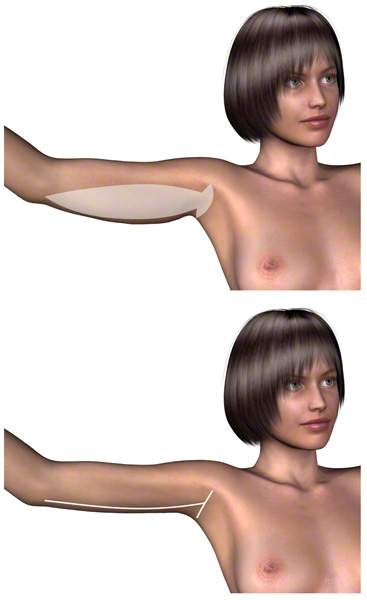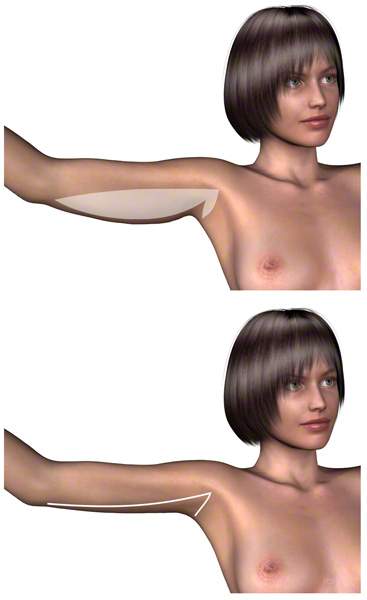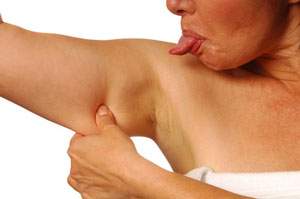Patients at the Yuveo Clinic Düsseldorf who have undergone significant weight loss are usually interested in an upper arm lift.
The improved physical well-being is then often overshadowed by excess sagging skin(flabby skin) and residual fat deposits.
It is not always just a case of excess skin. The residual fat deposits are typically localized on the back and inside of the upper arm.
It is not uncommon for the underarm extensions of the breast to also be a nuisance, which can leave a disturbing bulge after an upper arm lift with slimmer, firmer arms.
It therefore makes sense to remove this axle grease in order to achieve a more harmonious overall appearance.
Even people with pre-aged skin (usually due to sun and nicotine consumption) who are not satisfied with the situation on their upper arm often only see the possibility of improvement through an upper arm lift.
Contents
Yuveo Clinic
Special features of the upper arm lift
A welcome side effect is created when the excess upper arm tissue is tightened, as some of the sweat glands are also removed in the process.
Annoying axle grease
Two different surgical methods
Upper arm lift surgery
Procedure of the operation
General anesthesia is preferable for an upper arm lift, although local anesthesia with twilight sleep is also possible if the findings are not too pronounced.
In principle, the procedure can be performed on an outpatient basis. However, for more extensive operations, at least one overnight stay in hospital for observation is recommended.
After the operation, restricting movement of the upper arm and compression treatment with sleeves is important for good wound healing.
Upper arm lifts can also be used to correct extremely flabby upper arms, which are usually caused by severe weight loss. In some cases, it may be advisable to extend the incisions to the chest (with simultaneous tightening of the breast) or to the side of the ribcage.
To optimize the result, it often makes sense to combine the tightening procedure with liposuction of the upper arms, especially for somewhat larger upper arms. However, it should not be forgotten that this liposuction puts additional strain on the tissue, particularly in terms of blood circulation. Therefore, if a lot of fat needs to be removed first, the two procedures should be performed separately. After liposuction, the tissue then has enough time to recover.
Cutting guide
Before the upper arm lift, the estimated incision line is marked by us with an adhesive paint. This incision line depends on the extent of the excess tissue.
The incision usually extends from the armpit almost to the elbow joint and runs along the inside of the upper arm. In the armpit area, the line is curved in order to maintain freedom of movement in the shoulder joint in the event of subsequent scar shrinkage.
This also prevents the formation of a scar cord, which can be noticeable in the form of pulling pain when the arm is raised.


Frequently asked questions about an upper arm lift
How is excess tissue corrected during an upper arm lift?
During an upper arm lift, not only the excess skin but also the excess fat is removed almost down to the outer fibrous sheath of the muscles.
We protect vessels and nerves during this procedure and then suture the wound in several layers.
We use drains or small flaps to facilitate the drainage of wound fluid or blood.
This happens particularly in the first few days and can cause the dressing to become a little soaked with blood (quite normal to a small extent).
No underarm sweat after an upper arm lift?
As part of the upper arm lift, the sweat glands and a large part of the underarm hair are often partially removed. This is obvious, especially as the incision extends into the armpit. Most women see this as a pleasant side effect of an upper arm lift 
How is aftercare carried out for an upper arm lift?
Aftercare always depends on the findings before the upper arm lift and the extent of the operation required.
Associations:
Dressings with antibiotic-containing or antiseptic ointments (i.e. ointments that kill bacteria) are preferred after an upper arm lift due to their proximity to the armpit region. We change these dressings regularly. In addition, the suture points are moistened with disinfectant spray when the dressing is changed.
Importance of compression treatment:
Compression treatment for approx. 6 weeks after the upper arm lift is extremely important. Immediately after the operation, a wrap can be applied, after which measured or, in some cases, custom-made compression sleeves are recommended. If the compression on the upper arm is very strong but not on the forearm, the forearm and the entire hand can swell considerably. This can be prevented by an additional wrap on the forearm.
Restriction of movement
All movements that lead to instability of the suture site and the scar must be reduced after the upper arm lift, especially in the first 2 – 3 weeks.
Movements in the shoulder joint and in the shoulder girdle in general, especially spreading the arm to the side, are unfavorable for the healing process.
Sport should be stopped or reduced for at least 6 weeks. The same applies to all overhead movements.
Threads:
The stitches are removed approx. 2 weeks after the upper arm lift. The deep stitches dissolve by themselves.
Swelling and bruising:
In the first few days and weeks, swelling and slight bruising (also on the sides) of the skin are normal. This situation should be improved by the compression garment.
Fact check
- Practitioners: Dr. Schumann and Dr. Schumann-Averkiou
- Anesthesia: local anesthesia with twilight sleep, general anesthesia
- Hospitalization: outpatient or 1 day inpatient
- Follow-up treatment: Compression sleeves up to 6 weeks after surgery
- Remove stitches: after about 2 weeks
- Sport: Abstain from sport for 6 weeks
Further information and related topics
- Complications when tightening the upper arms
- You can find out more about underarm perspiration under Hyperhidrosis and Sweat gland removal.
Technical terms:
- Upper arm pexy = upper arm lift, upper arm lift


